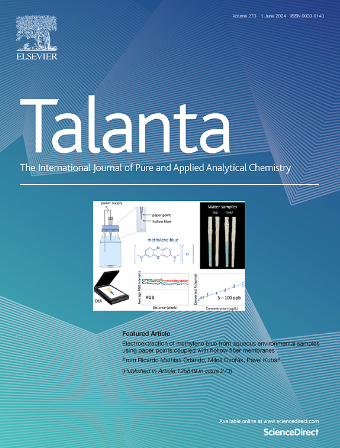Energy-level rich nanorings hybridizing Ag, Au and AgCl as high-performance SERS substrate for numerous molecules
IF 6.1
1区 化学
Q1 CHEMISTRY, ANALYTICAL
引用次数: 0
Abstract
The current surface-enhanced Raman scattering (SERS) substrates typically feature a single energy level, posing challenges in coordinating electromagnetic enhancement (EM) and chemical enhancement (CM), thereby limiting the sensitive detection of numerous crucial target molecules. In this study, novel aggregated nanorings (a-NRs) hybridizing Ag, Au and AgCl are constructed as SERS substrates. On one hand, the obtained a-NRs exhibit robust localized surface plasmon resonance absorption, whose wavelength can be tuned to match three commonly used laser wavelengths (532, 633 and 785 nm) to gain strong EM effect. On the other hand, these materials possess the Fermi levels of Au nanoparticles and Au/Ag alloy, in addition to the valence band and conduction band of AgCl. The abundant energy levels of the obtained a-NRs facilitate increased charge transfer opportunities for molecules, leading to a strong CM effect. Therefore, the obtained a-NRs show ultra-high SERS sensitivity towards numerous molecules. Moreover, the unique chemical composition makes the obtained a-NRs have good long-term stability in terms of SERS activity. Besides providing high-performance SERS substrates, the valuable experience for coordinating EM and CM to construct highly active SERS substrate demonstrated in this work are expected to significantly advance the application of SERS.

富含能量的纳米级杂化Ag, Au和AgCl作为许多分子的高性能SERS底物。
目前的表面增强拉曼散射(SERS)衬底通常具有单一能级,这在协调电磁增强(EM)和化学增强(CM)方面提出了挑战,从而限制了对许多关键目标分子的敏感检测。在本研究中,构建了一种新型的Ag, Au和AgCl杂交的聚集纳米结构(a-NRs)作为SERS底物。一方面,获得的a- nmr具有强大的局域表面等离子体共振吸收,其波长可调谐到与三种常用激光波长(532、633和785 nm)相匹配,以获得强的EM效应。另一方面,这些材料除了具有AgCl的价带和导带外,还具有Au纳米粒子和Au/Ag合金的费米能级。获得的a- nmr的丰富能级有助于增加分子的电荷转移机会,从而导致强CM效应。因此,获得的a- nmr对许多分子具有超高的SERS灵敏度。此外,其独特的化学成分使得所获得的a- nr在SERS活性方面具有良好的长期稳定性。除了提供高性能的SERS衬底外,本工作所展示的协调EM和CM构建高活性SERS衬底的宝贵经验有望显著推进SERS的应用。
本文章由计算机程序翻译,如有差异,请以英文原文为准。
求助全文
约1分钟内获得全文
求助全文
来源期刊

Talanta
化学-分析化学
CiteScore
12.30
自引率
4.90%
发文量
861
审稿时长
29 days
期刊介绍:
Talanta provides a forum for the publication of original research papers, short communications, and critical reviews in all branches of pure and applied analytical chemistry. Papers are evaluated based on established guidelines, including the fundamental nature of the study, scientific novelty, substantial improvement or advantage over existing technology or methods, and demonstrated analytical applicability. Original research papers on fundamental studies, and on novel sensor and instrumentation developments, are encouraged. Novel or improved applications in areas such as clinical and biological chemistry, environmental analysis, geochemistry, materials science and engineering, and analytical platforms for omics development are welcome.
Analytical performance of methods should be determined, including interference and matrix effects, and methods should be validated by comparison with a standard method, or analysis of a certified reference material. Simple spiking recoveries may not be sufficient. The developed method should especially comprise information on selectivity, sensitivity, detection limits, accuracy, and reliability. However, applying official validation or robustness studies to a routine method or technique does not necessarily constitute novelty. Proper statistical treatment of the data should be provided. Relevant literature should be cited, including related publications by the authors, and authors should discuss how their proposed methodology compares with previously reported methods.
 求助内容:
求助内容: 应助结果提醒方式:
应助结果提醒方式:


